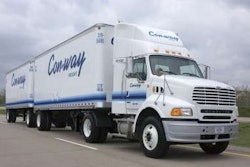The Motor & Equipment Manufacturers Association and its heavy-duty affiliate association, the Heavy Duty Manufacturers Association, today, April 24, lauded two legislators for reintroducing a measure that would provide tax credits to help facilitate the accelerated adopting of advanced safety systems for commercial vehicles.
The Commercial Motor Vehicle Advanced Safety Technology Tax Act of 2009 (H.R. 2024), reintroduced by Mike Thompson (D-Calif.) and Geoff Davis (R-Ky.) on Wednesday, April 22, would provide tax credits to help facilitate the accelerated adopting of advanced safety systems for commercial vehicles.
The bill includes electronic brake stroke monitoring systems, vehicle stability systems (electronic stability control and roll stability control), lane-departure warning systems (with blind spot detection) and collision warning systems (with adaptive cruise control). The legislation will encompass both the original equipment (OE) and aftermarket installation of these safety systems.
The bill also would:
“These tax credits will provide the necessary incentive for heavy-duty vehicle operators, especially those that are small to medium-sized companies and independent owner-operators, to purchase and install these safety-enhancing technologies in order to protect against traffic fatalities and injuries,” says Tim Kraus, HDMA president and chief operating officer.
Thompson and Davis were joined by 10 other original co-sponsors of H.R. 2024, which will make a wider range of safety equipment more affordable in order to meet heavy-duty vehicle owners and fleets’ specific needs.
“Safety on our nation’s highways has always been one of my primary concerns,” Thompson says. “With over 9 million large trucks and over 830,000 buses registered in the United States, accidents involving commercial vehicles continue to be a problem. Safety technologies can work hand-in-hand with regular safety enforcement in further reducing traffic fatalities and injuries. This legislation will provide the necessary incentives in installing these devices on large trucks, transit and school buses to help protect the commuting public.”
“Kentucky’s roads and highways are a major artery of our nation’s transportation infrastructure and are critical to the America’s economy,” Davis says. “More than 280 million tons of freight flow across Kentucky’s roadways annually. This legislation will improve the safety of our highways in the Commonwealth and throughout America. By increasing the safety of our roadways, we can reduce both the human and economic costs of highway accidents. In addition to improving safety, the bill will stimulate manufacturing to create and preserve jobs in these tough economic times.”
According to the U.S. Department of Transportation, there were more than 4,800 fatalities and 101,000 injuries in accidents involving heavy-duty vehicles on U.S. highways in 2007. A 2006 study released by the National Highway Traffic Safety Administration and the Federal Motor Carrier Safety Administration identified specific causes for heavy vehicle crashes; the study found that rear-end collisions, side-swipe accidents, brake problems and running off the road or out of the lane account for more than 60 percent of the total large vehicle accidents.
Heavy-duty vehicle suppliers currently are manufacturing technologies that address these specific types of accidents, Kraus says. “We commend Representatives Thompson and Davis for their understanding and leadership on this important issue,” he says. “We urge all members to support this critical bill. These technologies will have a tremendous positive impact in ensuring the safety of the traveling public.”











